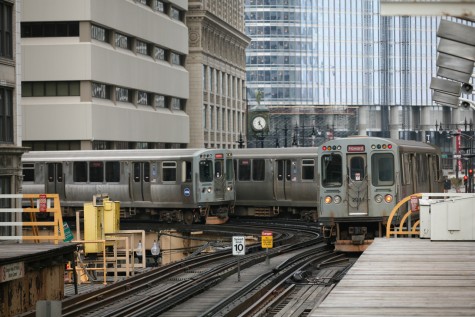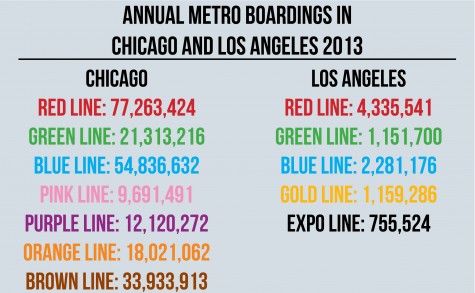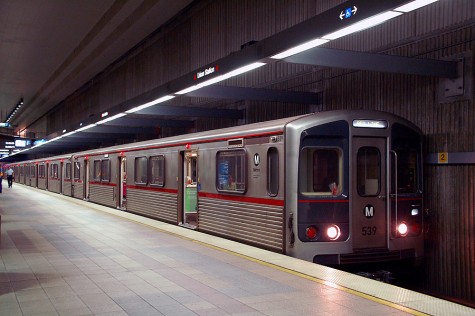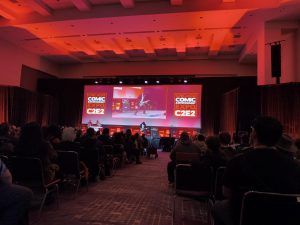Red Vs Red
Which Train Will Take First Rail?
March 10, 2015

Rerouted Chicago Red-Line trains lurking between the Randolph/
Wabash and State/Lake stops in the Loop.
If the elevated rail-lines of Chicago are a public treasure, the Red Line may be the ruby in the city’s crown.
The El is as much a symbol of the city of broad shoulders as the Willis Tower, Grant Park or Soldier Field. The Red Line, with 33 stations spanning some 21.8 miles from the northerly borders of Evanston and Rogers Park to Roseland in the south, an industrious traveler could hit almost every major bar of the North and South sides, visit both US Cellular and Wrigley Fields and visit the Willis Tower Skydeck in a single trip.
But the other Second City, the always sunny, always hilly Los Angeles, has utilized a five-cent sales tax since the ‘80s to revamp their public transportation network to extend throughout much of the city.
Historically, L.A. has been a car city since the 1920s. With rising oil prices and a grey cloud of smog persistently clogging the hills, that’s changing today. The Metro is growing, and like Chicago, Los Angeles also has a Red Line.
The Los Angeles Red Line zigzags across the northern half of the city, stretching almost 17 miles from the North Hollywood Station in the neighborhood of the same name to Union Station in downtown L.A.
There are some basic similarities between these two Red Lines: both run heavy rail cars; in Chicago’s case the 3200-Series and the more recent 5000-Series; and in L.A., the Breda a650; both lines are the most trafficked of their respective cities.

Riders and Riding Condition
On either Red Line, to some extent, you’ll see the same grungy mix of tourists, sad-eyed locals, sleeping vagrants and drunk and puzzled-looking vagabonds that grace any big city public transportation system.

Transit Authority. The Los Angeles Metro is up-to-date online.
The same air of musty desperation that pervades our own Red Line is present in full force on that of Los Angeles — it might, in fact, even be exacerbated by the dull, dystopian interior of the Breda a650.
The difference, then, is not so much in the quality of riders but the quantity.
Chi-town’s Red Line is immensely over-congested. In 2013, commuters accessed it almost 73 million more times than its L.A. counterpart.
This discrepancy in ridership provides a hell of a lot of breathing room in the L.A. subway. Even if the air quality there is none too great, it’s a far cry from a lung-full of Chicago Red Line musk.
Chicago’s North Side branch is utilized by a diverse array of professionals, workers and the ever-present homeless population. The poorest of the poor and the mildly wealthy sit, stand and ride side-by-side in relative peace.
The Red Line in L.A. is mostly deserted by the upper class. Save for late-night weekenders drunkenly fleeing Hollywood and Vine, you won’t find too many L.A. yuppies floating through the metro station at any time of the day. Their car culture is well established, and they prefer the freedom of the road — however brutally congested it may be — to the comparatively limited and claustrophobic confines of a subway station or car.

Rail Cars

The Chicago Red Line’s latest model railcar, the 5000-Series, manufactured by the Bombardier Transit Corporation in Plattsburgh, NY, was designed to conform to the appearance of the earlier (and still in operation) 2600-Series and its predecessor, the 3200-Series.
The Los Angeles Red Line runs the Breda a650: a bleak, 40-ton hog of an electric heavy-rail car, dimly lit with a beige interior and a minimalistic utilitarian design.
The a650 is a homely mess of a vehicle, a grotesque product of early ‘90s aesthetics — but it compensates for its unfortunate looks with pure functionality.
Capable of reaching 50 mph in 25 seconds, with a top speed of 70 mph, the a650 is well on par with both the 5000-Series and the 3200-Series.
Compared to any CTA vehicle, including the 5000-Series, the a650 is spacious. With 61 seats per car, a width of 10 feet, and 75 feet of standing and sitting room length-wise, Chicago’s rush hour Red Line traffic could, by comparison, fit snugly in the standing area of the a650 — and that’s not counting the sitters.
Though the difference in width is just over a foot, any jaded Chicago commuter can and will attest to the brutal, airtight conditions rush-hour riders are subjected to. Our Red Line is a high-speed, ultra-dense sausage—treating passengers to a tragic first-class whiff of the cosmopolitan odor.
Unlike earlier CTA railcars, the 5000-Series was designed with aisle-facing seating — a trend popular in NY, Tokyo, Paris and London, among other cities. This was done in part to provide riders with more standing room.
Indeed, that’s a noble effort — but is it enough?

Stations and Hours
The Los Angeles Red-Line subway stations are expansive: High vaulted ceilings, tile murals, and weird modernist architecture plastered throughout. The Hollywood and Vine station even has fake palm trees “planted” near its escalators. The stations, even those which are less than nice, have a vaguely futuristic feeling attached to them.
Besides being more spacious, the Los Angeles Subway is also relatively clean, especially compared to those of the El. Anti-littering laws must be enforced rigorously in LA — or there must be a team very dedicated to keeping the Subways clean.
That being said, the bathroom in L.A.’s Union Station must be held accountable for what it is: The worst bathroom in the United States; a tremendous pillbox pit, primed to 90 degrees by thick sulphuric clouds leaking invisibly from the stalls.
The differences in the subway stations of Chicago and Los Angeles, however, can be attributed to one thing alone: Age.
Chicago’s Subway system is pushing well over half a century now. Our subway was first launched in 1943, in the midst of the Second World War. Since then, it’s seen a lion’s share of repairs and upgrades, refurbishments, and structural damage. There are whole segments of the subway hidden away from public view — and intrepid commuters can utilize these areas to walk between the stations beneath the Chicago Loop.
The Los Angeles Red-Line, however, is very young. It’s only been in operation since 1993.
While some of the Chicago Red-Line’s subway stations have seen massive aesthetic upgrades, today, most are showing their age.
Where the Chicago Red-Line really has a leg up on that of Los Angeles is in its hours of use. The Chicago Red-Line runs 24-hours and seven days a week. The Los Angeles Red-Line runs between 4:30 a.m. and 1:00 p.m. on weekdays, and until 2:00 a.m on Friday and Saturday.
But there is one major boon to the Los Angeles Red-Line that Chicago’s is unlikely to adopt anytime soon: It can be boarded virtually for free. Granted, these boardings are not strictly legal — you’re expected to buy and own a metro pass to ride — but the boarding system is set up in such a way that it’s very easy to slide through one of the poorly secured gates and into the subway station. Hopping a turnstile in Chicago, on the other hand, is a good way to earn a ticket or get kicked off the platform.
A warning for tourists: The Los Angeles Metro Day-Pass, as was discovered by a colleague of mine, does not last for 24 hours. It lasts until the end of the day — regardless of when it was bought. Visitors should plan accordingly, and maybe skip the day-pass for a normal Metro card.

But Which Train is the Victor?
Ah. How easy it would be to declare one of these lines the irrefutable winner and be done with this whole ordeal. Reality, however, is not so simple.
This article has been written under a somewhat false pretense because, unfortunately, the public transportation systems of Chicago and Los Angeles are not really comparable under any fair criteria. A brief glance at the ridership statistics posted above makes this as clear as water. These are two very different beasts: One an ancient giant, and the other a newborn cub.
Chicago’s Red-Line is a fixture of our city, and is going to remain so for the foreseeable future. The Los Angeles Red-Line, while not as extensive, is a model operation for cities across America looking to delve head-first into public transportation.











Shawn • Jul 11, 2015 at 10:37 pm
The Chicago Red Line didn’t have nearly 73 million more riders in 2013 than the LA Red Line. You’re comparing the annual numbers for Chicago with the monthly numbers for LA.